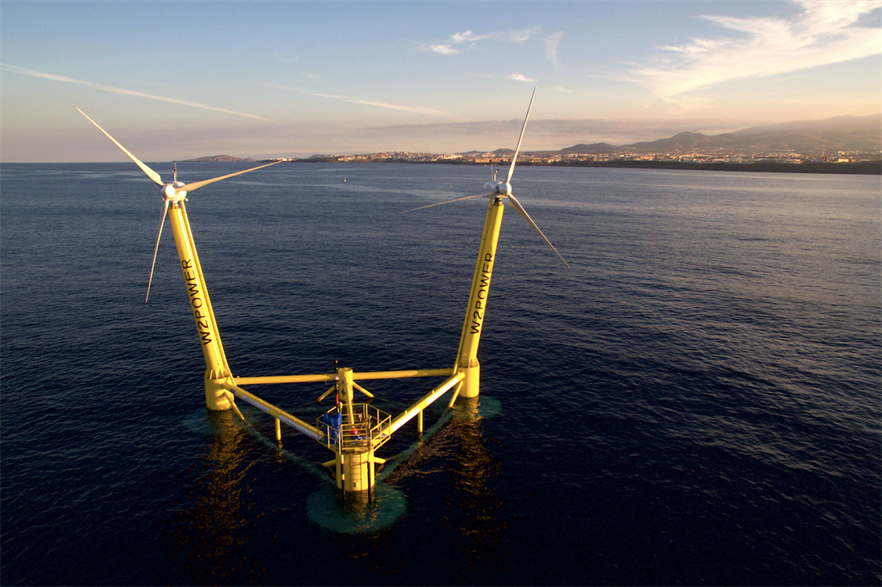News & Events
Ceit works on new solutions to combat corrosion on offshore platforms

04 | 09 | 2023
The Ceit Technology Centre is the technical coordinator of the HarshMop project, which seeks to develop both a monitoring system and new coatings in order to protect the structure of offshore floating platforms against corrosion.
The HarshMop project seeks to reduce costs, optimise maintenance and increase the lifespan of offshore structures, in turn fostering the generation of renewable energy.
Offshore or marine platforms play a crucial role in generating renewable energy on the high seas. However, they face major challenges such as corrosion, which is one of the main problems causing structural faults on these platforms. Therefore, continuous monitoring of this process is of the utmost importance, which translates into costs owing to difficulties in terms of access and the large area that needs to be covered by the monitoring system.
At present, there are no non-intrusive, autonomous systems for monitoring integrated corrosion being used on floating platforms. Additionally, current coatings used to protect against corrosion remain limited in terms of durability and mechanical properties.
An adaptable, unsupervised system
The HarshMop project– an initiative put forward by the Public-Private Collaboration Programme within the framework of the Recovery, Transformation and Resilience Plan - has been set in motion to tackle these problems. The main aim of the HarshMop consortium comprising Ingeteam, Enerocean, Plocan, Lurederra and the Ceit Technology Centre is to design a monitoring system that combines corrosion supervision with turbine monitoring by bringing together data pertaining to physical and chemical parameters about the sea, as well as marine climate data. Additionally, it seeks to complement this monitoring system by the development of new coatings in order to improve protection against corrosion in the structure of floating platforms.
The solution being proposed seeks to be adaptable and to work unsupervised over long periods of time. To this end, specific applications need to be taken into consideration, as the corrosion phenomenon may vary according to the use being made of the platform, and it is also necessary to take into account different areas of interest such as the submerged parts and splash and atmospheric areas, in addition to the environmental conditions to which the system is exposed.
Monitoring and protection against corrosion
To monitor corrosion, HarshMoP proposes the use of ultrasound technology in combination with UWB (ultra-wideband) and LF (low frequency) wireless communication Specifically, Ceit will be the technical coordinator for the project that will be working on this technology, which will enable accurate measurements to be taken of the material’s thickness, as well as data transfer both on the surface and underwater.
In terms of protection against corrosion, the design and development of a nano-coating is being taken into consideration with anti-corrosive properties for metal substrates. This coating seeks to prolong the lifespan of those elements which are most prone to corrosion on these floating platforms. Unlike current coatings, it seeks to use inorganically predominant hybrid formulations that will allow for greater applicability, lower energy consumption with regard to application and treatment, and also less additional weight in the parts and platforms being treated.
A unique system
At present, there is no continuous monitoring system for corrosion that is able to take accurate and reliable measurements of thickness in rapid succession, and which may also operate and transfer data pertaining to any loss in thickness and the structural health of the wind turbine to the cloud. Parallel to this, it is also hoped that a protective system will be developed based on new coatings that will overcome the limitations imposed by current commercially available coatings.
As a result of all the aforementioned, it is hoped that the project will manage to reduce costs, optimise maintenance and increase the lifespan of offshore structures, in so doing promoting the generation of renewable energy and helping to reduce greenhouse effect gases. Thus, by implementing HarshMoP, it is hoped that offshore platforms will become more efficient, safe and sustainable in the future.
About Ceit
Ceit is a technology centre that forms part of the Basque Research and Technology Alliance (BRTA) and was set up in 1982 on the initiative of the University of Navarra.
Ceit is a not-for-profit organisation whose mission is to improve company competitiveness via the transfer of technology. The centre has a specialisation strategy that focuses on state-of-the-art manufacturing, sustainable mobility and the circular economy.